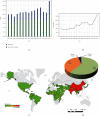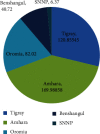Economics of Sesame and Its Use Dynamics in Ethiopia
- PMID: 36081605
- PMCID: PMC9448608
- DOI: 10.1155/2022/1263079
Economics of Sesame and Its Use Dynamics in Ethiopia
Abstract
Ethiopia's oilseed industry makes a major contribution to foreign exchange revenues. Ethiopia's three main oilseed crops (sesame, soybean, and Niger seed) account for about 20% of the country's total agricultural export profits, second only to coffee. Even though Ethiopia is one of the world's largest producers and exporters of sesame seeds, the country is facing increasing supply and demand restrictions. This paper begins with an examination of one of the most prominent oil crops in the country. It is a highly adaptable crop that may be used for anything from subsistence to commercial output. We established a comprehensive scientific understanding of the crop using a systematic review of the current literature and deductive logical reasoning that can be used to inform future research and policies. Various exclusion and inclusion criteria were used to filter the most notable findings. Millions of growers and other market participants are employed throughout the oilseed value chain. Reduced sesame productivity, pests and diseases, and limited access to modern technologies are all severe supply-side constraints. On the demand side, traders and market distortion, as well as an artificially higher home price and the ease with which unskilled labor can enter the market, are all factors. Other demand-side constraints include worldwide price volatility, a highly concentrated export market, and intense global competition. Ethiopia's sesame seed development potential is being severely hampered by these restrictions. If farmers, dealers, and the government do not address these issues strategically, the country may soon lose its competitiveness in the global sesame seed market. This will contribute to Ethiopia's ongoing discussion about how to better inform private and public sector policies and investments to increase sesame production, transform agriculture, improve nutrition and food systems, and be able to ease supply- and demand-side restrictions. In a nutshell, an increased area under cultivation combined with best agronomic practices could boost sesame production. Farmers, policymakers, researchers, and other stakeholders must thus intervene to enhance sesame production. Future studies should concentrate on how to boost sesame output in farmers' fields while following appropriate sesame production technology and agronomic principles.
Copyright © 2022 Teshome Sirany and Esubalew Tadele.
Conflict of interest statement
The authors declare that they have no conflicts of interest.
Figures










Similar articles
-
A rapid and systematic review of the clinical effectiveness and cost-effectiveness of paclitaxel, docetaxel, gemcitabine and vinorelbine in non-small-cell lung cancer.Health Technol Assess. 2001;5(32):1-195. doi: 10.3310/hta5320. Health Technol Assess. 2001. PMID: 12065068
-
Home treatment for mental health problems: a systematic review.Health Technol Assess. 2001;5(15):1-139. doi: 10.3310/hta5150. Health Technol Assess. 2001. PMID: 11532236
-
Cost-effectiveness of using prognostic information to select women with breast cancer for adjuvant systemic therapy.Health Technol Assess. 2006 Sep;10(34):iii-iv, ix-xi, 1-204. doi: 10.3310/hta10340. Health Technol Assess. 2006. PMID: 16959170
-
A rapid and systematic review of the clinical effectiveness and cost-effectiveness of topotecan for ovarian cancer.Health Technol Assess. 2001;5(28):1-110. doi: 10.3310/hta5280. Health Technol Assess. 2001. PMID: 11701100
-
Eliciting adverse effects data from participants in clinical trials.Cochrane Database Syst Rev. 2018 Jan 16;1(1):MR000039. doi: 10.1002/14651858.MR000039.pub2. Cochrane Database Syst Rev. 2018. PMID: 29372930 Free PMC article.
Cited by
-
Molecular Diversity and Agronomic Performance of Sesame (Sesamum indicum) Cultivars in Benin: Local Cultivars and Lines Introduced From China.Plant Environ Interact. 2024 Dec 24;5(6):e70024. doi: 10.1002/pei3.70024. eCollection 2024 Dec. Plant Environ Interact. 2024. PMID: 39723415 Free PMC article.
-
Modeling the response of sesame (Sesamum indicum L.) to different soil fertility levels under rain-fed conditions in the semi-arid areas of western Tigray, Ethiopia.Heliyon. 2024 Aug 10;10(17):e36084. doi: 10.1016/j.heliyon.2024.e36084. eCollection 2024 Sep 15. Heliyon. 2024. PMID: 39296240 Free PMC article.
References
-
- Girmay A. B. Sesame production, challenges, and opportunities in Ethiopia. Vegetos- An International Journal of Plant Research . 2018;31(1) doi: 10.5958/2229-4473.2018.00007.1. - DOI
-
- Gashaw G. The Ethiopian herald (Addis Ababa) 2021. https://www.press.et/english/ - PubMed
-
- Chau C. F., Ciou J. Y., Wu C. L. Commercialized sesame oil analysis: quality characterization and oxidative stability of blended sesame oil. ACS Food Science & Technology . 2021;1(7):1222–1227. doi: 10.1021/acsfoodscitech.1c00008. - DOI
-
- Queiroga V. P., Duran J. M., Santos J. W., Queiroga D. A. N. Effect of cotton seed coating on its physiological quality. Brazilian Journal of Oilseeds and Fibers . 2007;11(3):131–137.
Publication types
MeSH terms
LinkOut - more resources
Full Text Sources

